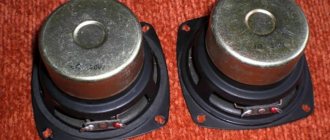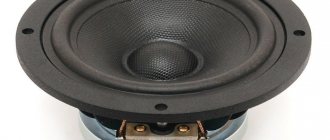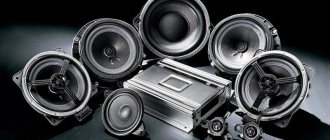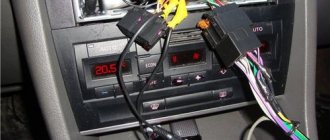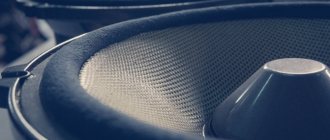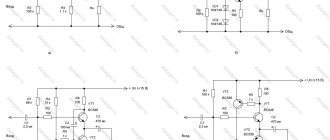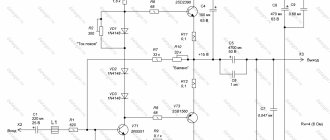Hi all! Today I will try to talk about the main parameters of car subwoofers. What might they be needed for? And they are needed in order to correctly assemble the box for your speaker. If you do not calculate the future box, the subwoofer will hum and there will be no loud and deep bass. In general, a subwoofer is an independent acoustic system that plays low frequencies from 20 Hz to 80 Hz. It's safe to say that without a subwoofer you will never get high-quality bass in a car. The speakers, of course, try to replace the woofer, but it turns out weakly, to put it mildly. A subwoofer can help unload the speakers by taking over the low-frequency range, while the front and rear speakers will only have to play the middle and high frequencies. Thanks to this, you can get rid of distortions in the sound and get a more harmonious sound of music.
Now let's discuss the main parameters of the woofer. Understanding them will be very useful when building a subwoofer box. The minimum data set looks like this: FS (speaker resonant frequency), VAS (equivalent volume) and QTS (total quality factor). If the value of at least one parameter is unknown, it is better to abandon this speaker, because... It will not be possible to calculate the volume of the box.
Resonance Frequency (Fs)
Resonant frequency is the resonance frequency of the woofer head without design, i.e. without a shelf, a box... It is measured as follows: the speaker is suspended in the air, as far as possible from surrounding objects. So its resonance will depend only on itself, i.e. on the mass of its moving system and the rigidity of the suspension. There is an opinion that a low resonant frequency allows you to make an excellent subwoofer. This is not entirely true; for certain designs, too low a resonance frequency will only be a hindrance. For reference: low resonance frequency is 20-25 Hz. It's rare to find a speaker whose resonant frequency is below 20 Hz. Well, above 40 Hz, it will be too high for a subwoofer.
Power
Nominal – power parameter for continuous operation. This is the main indicator of power. The rated power of the speakers should be equal to the rated power of the amplifier, or even better - be less. Otherwise, the speakers will be damaged at high volumes. The optimal speaker power indicator is 50-80 W.
Maximum – power parameter for short-term operation (with overloads). It is desirable that the maximum power of the speakers be twice that of the amplifier or radio.
Important: check the rated power value, since manufacturers often indicate only the maximum power on the product packaging.
Total quality factor (Qts)
In this case, it does not mean the quality of the product, but the ratio of viscous and elastic forces existing in the moving system of the LF head near the resonance frequency. The moving system of the speaker is very similar to the suspension of a car, which contains a shock absorber and a spring. The spring creates elastic forces, that is, it collects and releases energy during movement. In turn, the shock absorber is a source of viscous resistance; it does not accumulate anything, but only absorbs and dissipates in the form of heat. A similar process occurs when the diffuser and everything attached to it vibrates. The higher the quality factor, the more elastic forces predominate. It's like a car without shock absorbers. You hit a small bump and the wheels jump on one spring. If we talk about dynamics, this means an overshoot from the frequency response at the resonance frequency, the greater the greater the total quality factor of the system. The highest quality factor is measured in thousands, and only for the bell. It sounds exclusively at the resonant frequency. A common way to check a car's suspension is by rocking it from side to side, which is a homemade way to measure the quality factor of the suspension. The shock absorber destroys the energy that appeared when the spring was compressed, i.e. Not all of it will come back. The amount of wasted energy is the quality factor of the system. It seems that everything is clear with the spring - its role is played by the diffuser suspension. But where is the shock absorber? And there are two of them, and they work in parallel. Total quality factor consists of two: electrical and mechanical.
The mechanical quality factor is usually determined by the choice of suspension material, mainly the centering washer. As a rule, losses here are minimal, and the total quality factor consists of only 10-15% mechanical.
The majority is electrical quality. The stiffest shock absorber available in a speaker propulsion system is a tandem magnet and voice coil. Being essentially an electric motor, it operates as a generator near the resonance frequency, when the speed and amplitude of movement of the voice coil is maximum. Moving in a magnetic field, the coil generates current, and the load of the generator is the output resistance of the amplifier, i.e. zero. The result is the same electric brake as on electric trains. There, in approximately the same way, traction motors are forced to work as generators, and brake resistor batteries on the roof act as a load. The amount of current generated will depend on the magnetic field. The stronger the magnetic field, the greater the current will be. As a result, it turns out that the more powerful the speaker magnet, the lower its quality factor. But, because When calculating this value, you need to take into account both the length of the winding wire and the width of the gap in the magnetic system; it will not be correct to draw a final conclusion based on the size of the magnet.
For reference: a low speaker Q will be less than 0.3, and a high Q will be more than 0.5.
Selecting a tweeter
When choosing a tweeter, the frequency response determines the lower frequency of the range it reproduces. It is necessary that the frequency band of the tweeter somewhat overlaps the frequency band of the woofer.
Some tweeters are designed to work in conjunction with a horn. Unlike direct-radiation tweeters (or tweeters, as they are called), horn tweeters, due to the properties of the horn, have a lower cutoff frequency of the reproduced audio range. The lower limiting frequency of such a high-frequency speaker can be approximately 2000-3000 Hz, which makes it possible in many cases to abandon the midrange speaker in the speaker system.
Due to their design, tweeters tend to have higher sensitivity than woofers. Therefore, at the filter design stage, an attenuator (suppressor) circuit is provided in it, which is necessary to reduce excess radiation, which brings the sensitivities of the high-frequency and low-frequency speakers to the same level.
When choosing a tweeter, it is important to consider its power, which is selected based on the power of the woofer. In this case, the power of the HF speaker is taken lower than the power of the LF speaker, which follows from the analysis of the spectral density of the audio signal, corresponding to pink noise (which has a decline towards high frequencies). For a practical calculation of the power dissipated by the high-frequency dynamics in speakers with a crossover frequency of 3-5 kHz, you can use the calculator on our website.
Let us remind you that HF speakers cannot be used without a high-pass filter (HPF), which limits the penetration of the low-frequency part of the spectrum.
Equivalent volume (Vas)
Most modern speakers are based on the principle of “acoustic suspension”. The point is that you need to select a volume of air at which its elasticity will correspond to the elasticity of the loudspeaker suspension. That is, another spring is added to the speaker suspension. If the new spring is equal in elasticity to the old one, this volume will be equivalent. Its value is determined by the diameter of the speaker and the stiffness of the suspension.
The softer the suspension, the larger the air cushion will be, the presence of which will begin to vibrate the head. The same thing happens when changing the diameter of the diffuser. A larger diffuser, with the same displacement, will compress the air in the box more strongly, and thereby experience greater output. This is exactly what you should pay attention to when choosing a speaker, because the volume of the box depends on this. The larger the diffuser, the higher the output of the subwoofer will be, but the size of the box will also be impressive. The equivalent volume is strongly related to the resonant frequency, without knowing which you can make a mistake. The resonant frequency is determined by the mass of the moving system and the rigidity of the suspension, and the equivalent volume is determined by the same rigidity of the suspension and the diameter of the diffuser. It can happen like this: there are two woofers of the same size and with the same resonance frequency, but for one of them the resonance frequency depends on a heavy diffuser and a hard suspension, and for the second - on a light diffuser and a soft suspension. The equivalent volume, in this case, can differ very significantly, and when installed in the same box, the results will be very different.
I hope I helped a little to understand the basic parameters of woofers.
Thiel and Small
Thiel and Small are two scientists who have formed a single, generally accepted approach to calculating the characteristics of woofer speakers based on fundamental parameters (Fs, Qts, Vas).
Neville Thiel/A. Neville Thiele (left), Richard Small (right)
Thiel-Small parameters determine the behavior of the speaker in the low frequency range
For you and me, these parameters are very important, since they are used to calculate the correct acoustic design of the speaker or, more simply, to calculate the subwoofer housing. You can find all the necessary data in the technical documentation for the sub; they are often indicated on the boxes. Below we will take a closer look at the main parameters for understanding sound processes and nuances when choosing a subwoofer.
Adviсe
- Buy car audio in specialized stores. Pay attention to speakers from well-known brands that value their reputation. Request a quality certificate from the seller. And do not forget to make sure that there is a warranty and the possibility of providing service.
- Remember that the technical holes for speakers may differ for different car models and brands. By purchasing speakers of appropriate dimensions, you thereby facilitate the installation of speakers.
- If your car has a radio with a GPS module, then for the navigation system to work correctly you need to install only those brands of acoustics recommended by the manufacturer. Otherwise, the speakers will make it difficult to receive the satellite signal.
- When choosing speakers, take into account the technical standards of the radio (specified in the operating manual). It makes no sense to buy expensive and powerful acoustics for a cheap radio in order to improve the sound quality.
- To achieve high-quality sound, you need sound insulation, which dampens extraneous sounds from the wheels and engine. To do this, the doors, roof, floor, and space between the engine compartment and the passenger compartment are covered with special material.
- Installing an acoustic system is a complex matter, requiring specific knowledge and skills. Therefore, trust the installation of speakers in your car to professionals.
Levels
Initial - inexpensive acoustics that provide acceptable sound for an undemanding listener. The entry-level speaker is connected to the radio without an external amplifier. Layout: coaxial or component acoustics (front), pancakes (rear).
Medium is a more “advanced” speaker, which is reflected in its cost. Such acoustics show excellent results when connected to an external amplifier. Mid-range speakers often use podiums and silk dome tweeters.
High – expensive speakers with high-quality sound. The effectiveness of such acoustics depends on the quality of each element of the system, audio recording, and installation nuances. High-level acoustics require sound insulation and podiums.
Professional - differs in layout from previous options: spaced speakers, consisting of tweeters, midrange speakers and midbass. There are no rear speakers, and instead of one pair of speakers, two are installed in front. This type of speaker is the most expensive and is selected by professionals.
Based on their sound characteristics, acoustics are divided into three types:
- Speakers with pronounced lows and highs (club sound);
- Speakers with accentuated mids and clear highs, as well as low-end support from a subwoofer;
- Speakers with a very wide and even frequency range (universal option).
Overview of speakers of different sizes
We offer you to get acquainted with some popular models of low-frequency acoustics.
Component speakers
FOCAL PERFORMANCE PS 165
This system is 16 cm in size. The French manufacturer has created one of the highest quality kits for cars. The equipment reproduces clear sound and has adjustable crossovers. This is a two-way speaker with a power of 80 watts. (nominal) and 160 W. (maximum). The speakers are made of durable aluminum. They are characterized by pleasant bass, clear, dense sound, and laconic design. Very convenient and easy to install in any standard meta in the cabin.
Car speakers (16 cm) Focal Performance PS 165 FX
Users saw some shortcomings here:
- Very short power cord;
- if the bass is too high, you can hear noise (in rare cases);
- To maximize comfort when using such speakers, you need to connect an amplifier.
Focal is an expensive set of acoustics: 17,500 rubles.
ALPINE SGP-10CS
Great audio system. No amplifier. The design includes ventilation channels to properly distribute air flow. 16 cm two-way system with smooth, high-quality sound. External crossover included. The tweeter is made of high-quality, durable silk. Frequency from 68. But, with proper configuration, it plays bass perfectly. The Alpin set costs 6,200 rubles.
Car speakers ALPINE SGP-10CS
HERTZ ESK 165L.5
This setting is recommended for lovers of loud bass. The cellulose tweeter has a protective impregnation, and the dome has a wide emission angle. All acoustics are distinguished by the high quality of the materials from which they are created. Rubberized rear, the basket is protected from damage and corrosion. Frequency from 50. External crossover included. Excellent sound range.
Car speakers HERTZ ESK 165L.5
But there are also disadvantages to the equipment:
- In severe frosts, the system needs to warm up for a long time;
- sound adjustment is carried out using an equalizer.
The average cost of Italian speakers is 8800 rubles.
KICX ALN 8.3
Three-way acoustics measuring 20 cm. A special feature of the system are aluminum diffusers. They are a little harsh sounding. Aluminum can withstand loads and changing sound frequencies well. At the same time, it is resistant to differences in temperature and humidity. Frequency from 40 Hz. The speakers are equipped with a crossover. Low frequencies are reproduced perfectly. Clear sound for any genre of music. The price of the equipment is within 7,700 rubles.
Car speakers KICX ALN 8.3
Equipment
External crossover – divides the input signal into separate frequency ranges (MF, LF, HF). Budget models use a crossover that is built into the speaker housing. In more expensive devices it is external (separate unit). This option breaks up the sound better and distorts less, and also allows you to fine-tune the sound.
There are two types of connectors:
- screw clamps – highly reliable;
- spring latches are easy to use and are found in budget speaker models.
Gold-plated contacts on the connectors are resistant to oxidation, characterized by low resistance, and reliably connect the speaker to the connected wires.
Ferrofluid cooling - removes heat from the voice coil that is generated when the speakers are running at full power and which accelerates speaker wear.
Protection from moisture – relevant for cars with an open body type, boats or yachts.


